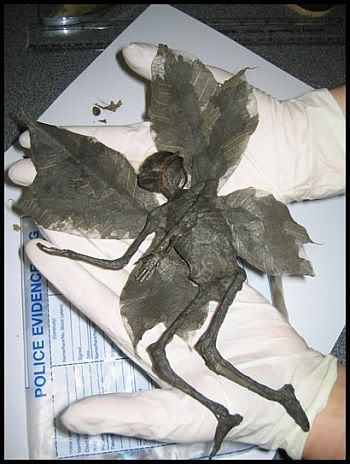Netlore Archive: Emailed photos purport to show mummified remains of a fairy (aka 'butterfly man' or 'moth man') discovered in the Derbyshire countryside of England
Description: Emailed images
Circulating since: April 2007
Status: April Fools hoax
Analysis: See below
Maybe not anymore but a recent discovery would suggest that they probably did. What appear to be the mummified remains of a fairy have been discovered in the Derbyshire countryside.
The 8inch remains complete with wings, skin, teeth and flowing red hair have been examined by anthropologists and forensice experts who can confirm that the body is genuine. X-rays of the 'fairy' reveal an anatomically identical skeleton to that of a child. The bones however, are hollow like those of a bird making them particularly light. The puzzling presence of a navel even suggests that the beings reproduce the same as humans despite the absence of reproductive organs.


Comments: BBC News has confirmed that the images and text above were created as an April Fools prank by Dan Baines, whose job is designing "strange and unique" illusions for stage magicians. The story of the mummified fairy's discovery was first posted in March 2007 on Baines' Website, Lebanon Circle Magic Company, where it attracted as many as 20,000 hits in a single day. After confessing to the hoax he sold the fake artifact on eBay for £280. Many people, he says, continue to insist it's real.
The prank calls to mind the infamous Cottingley Fairies hoax of 1917, wherein a pair of young British girls with too much time on their hands concocted fake photographs of tiny, humanoid fairies flitting through the air. The photos were vetted as authentic by none other than Sir Arthur Conan Doyle, author of the Sherlock Holmes series, and received an inordinate amount of publicity from a credulous press. It wasn't until 66 years later, in 1983, that one of the girls confessed that the fairy images had been hand-drawn and suspended in the air via hatpins to be photographed.
Gaff art
Baines' work is an outstanding example of what is called "gaff art," the use of taxidermy and prop-building techniques to create realistic-looking sideshow artifacts. One famous example was P.T. Barnum's half-ape, half-fish Feejee Mermaid, which astonished visitors to his American Museum in the mid-1800s. More recent examples, such as Juan Cabana's "Golden Mermaid" carcass, have won fame and infamy thanks to images circulated via the Internet.
Email This Article




No comments:
Post a Comment